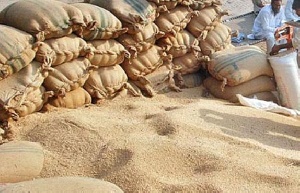 Ghana imports about 55,000 metric tonnes of wheat flour annually
Ghana imports about 55,000 metric tonnes of wheat flour annually
Ghana imports on the average 55,000 metric tonnes of wheat flour annually for local consumption.
Ministry of Food and Agriculture data shows that since 2004, there has been 160 percent increase in the volume of the commodity imported annually.
The foreign exchange requirements for wheat grain and wheat flour imports have ranged between US$118 and US$214 million between 2007 and 2013, according to the Food and Agricultural Organisation (FAO).
Should a 10% wheat substitution in the flour composition be considered, this would translate into between US$11 and 21 million of foreign exchange savings.
The Ministry of Food and Agriculture is, therefore, seeking to commercialize the production of high quality cassava flour as a substitute for wheat flour in the making of various products such as bread, pizza, cakes and pastries among others.
Cassava flour, which is soft and powdery, is very mild and neutral in flavour. Experts say it is a perfect substitute for wheat flour and ideal for gluten-free, grain-free baking and cooking.
Its high carbohydrate property makes it a great source of energy for very active people. For instance, cassava flour has double the calories and carbohydrates as sweet potato per 100 grams.
MoFA’s new study on how to produce high quality cassava flour to serve as a substitute for wheat flour has become crucial given the sheer volume of wheat flour imported into the country, which negatively impact of the country balance of trade.
MoFA’s initiatives, over the years, have brought about significant boost in the production levels of cassava as well as the development of a number of products which needs to be integrated into the industrial market.
However, the scale of production, consumer acceptability and product quality is still at the lowest stage and this is partly because of the absence of a policy and legal framework for the use of these products and inadequate consumer awareness and emphasis on the commercial viability of cassava value addition.
Acting Director, Directorate of Crop Services, MOFA, Osei-Akoto, at a recent validation workshop on the policy report said: “The background to the study was generally to examine the possibilities for HQCF to partly substitute wheat flour in the preparation of composite flour, taking into consideration economic and social advantages, safety and quality standards as well as the legislative framework required.”
Cassava is one of five food security crops prioritized by Ghana's Food and Agricultural Sector Development Policy. The cassava value chain contributes about 22% to Ghana's agricultural GDP, FAO Country Representative, Dr. Abebe Haile-Gabriel said
With many people engaged in activities related to cassava it contributes significantly to incomes and rural livelihoods for both men and women. Ghana is the third leading cassava producer in Africa and sixth in the world, he added.
According to the Ministry of Food and Agriculture, Ghana produces about 16 million metric tonnes of cassava; of which an estimated 11 million tonnes is available for human consumption. It is, however, reported that only four million tonnes of the crop available for human consumption makes it to our table, leaving more than seven million tonnes as surplus. With the right mechanisms and policy direction, the crop could be a valuable foreign income earner for the country at large.
Cassava thus holds an untapped promising market through the production and use of high quality cassava flour (HQCF) as a component of composite flour in the bakery sector. It can also find demand in the plywood manufacture as well as for other alternative products such as instant fufu in Ghana and fermented fufu in Nigeria.
However, for HQCF to be competitive to “imported wheat flour”, the issues of cassava productivity, postharvest management and value addition, appropriate and efficient processing facilities need to be critically looked at from policy of view. In this, respect the laudable “One District One Factory” initiative of his Excellency, Nana Akufo Addo can provide the needed impetus to drive the industrialisation at grass root levels using cassava-processing derivatives such as HQCF as an entry point.